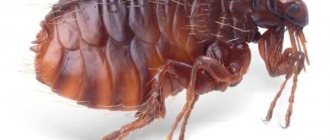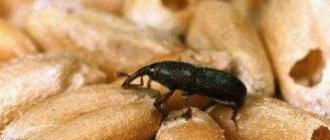In the kitchen, every caring housewife must have an assortment of cereals: buckwheat, rice, wheat, semolina, oatmeal and pearl barley. By including cereal dishes in your daily menu, you can get a nutritious, varied and healthy table. Cereals have a long shelf life, but if stored incorrectly or for too long, they create a threat of pests. They especially love bulk products: bread grinder, red flour beetle, flour bug, food moth.
To protect cereals from the appearance of tenants in them, you should follow the basic rules for their storage, starting from the day of purchase. Basic methods of protection.
Using spices
Shelves and cabinets with containers filled with cereals and flour can be made unpleasant for pests by placing dried cloves, garlic, bay leaves or red hot pepper pods on them. You can also put a small amount of spices inside the jar, but you will have to rinse the cereal well before cooking.
How to get rid of bugs in cereals and prevent them from appearing again
Tips for storing cereals
Each cereal will be stored in a separate container, which must be thoroughly washed, sterilized and dried. The slightest drop of water will ruin the entire jar or container. Before closing the lid on the jar, cover the neck with paper and then rotate the lid. As a precaution, place bags filled with salt next to the containers.
If bugs have already taken up residence in your cabinet, place lavender and chestnuts on the shelves.
As for air humidity, it should not be more than 70%. A sudden increase in temperature can cause food spoilage. +15-18C is the optimal storage temperature.
Neighborhood check
Periodic inspection of all cereals for the presence of food pests is mandatory. If you find the slightest hint of them, go through all the supplies, throw away the unusable ones, treat the surfaces with soapy water, paying special attention to the cracks between the walls.
The question of how to protect cereals from pests is very important and relevant. Having appeared in one of the types of bulk products stored at home, the bugs rapidly multiply and spread around, capturing more and more new places and infecting food products that come their way. Getting rid of them once and for all is difficult and painfully difficult. It will take a lot of time and every effort. It is easier to prevent their occurrence than to waste time and effort fighting them later.
Shelf life
Cereals are stored for a long time only when favorable conditions are created for them. The taste, of course, changes over time, but the quality remains the same. Storage time is several months, but depends on the type of cereal itself. Refrigeration may extend shelf life. If you do not have storage conditions, then you do not need to purchase large quantities of bulk products at once. Rice, corn, and buckwheat do not absorb odors and are stored for a long time. Flour and semolina are kept in the refrigerator for a whole year. In any case, inspect your supplies frequently for insects.
Cycle and lifespan
Caterpillars emerge from the laid eggs and turn into butterflies.
Having reached puberty, butterflies lay offspring. In favorable conditions of city apartments and houses, this cycle can continue all year round without interruption. It moves little and only at twilight, since the wings are poorly developed and there is no protection from predators.
Stages preceding puberty:
- laying eggs. Young caterpillars appear on average after 2 weeks at room temperature;
- The larvae make a cocoon around themselves from the stratum corneum and live in it for a long time, from 90 to 300 days per year.
Rules for storing sugar and flour
Large bags weighing 10 kg are never stored on the floor, no matter how convenient it may be for you. There must be a stand. Lemon zest will protect you from pests. Place the pieces in the bag and problem solved. You can make your own canvas bags for flour and sugar by sewing ties on top for convenience. The bag is first soaked in saline solution and dried without rinsing. This is reliable protection against insects.
Air humidity should be no more than 75%. Otherwise mold will occur.
Preventing food moths in the kitchen
To prevent food butterflies from appearing in your kitchen, you need to follow some rules .
- When buying cereal, you need to heat it in the oven or in the microwave.
- Check store products for food moth content.
- Store pasta and cereals in jars, preferably glass, with tight lids.
- The kitchen must be clean. It is necessary to periodically wipe the shelves with a vinegar solution, ventilate them and use aromatic sachets to get rid of insects.
- After some time, make an audit of food supplies, and calcinate cereals that have been stored for a long time.
- Do some general cleaning, especially in the corners of the apartment. Reconsider things that have been lying around for a long time, pillows, feather beds. The butterfly may also be in your things. If you do not completely destroy all deposits of larvae, then there is a possibility of an insect appearing in the kitchen.
- Don't buy discounted products. There is a good chance that the store wants to get rid of an item that has been attacked by insects.
- Cover the ventilation grille with a fine mesh. This procedure will not allow miles to enter the apartment.
- Place garlic in hermetically sealed jars with cereals. This will not affect the taste of the product, but will protect against the possibility of food moths.
- Place a clean nail at the bottom of the jar, and then fill it with cereal. This method was used during the war to protect food from food moths.
- Put fruits in the refrigerator compartment. This method will help prevent insects from appearing in the apartment.
- Clean around the sink and table thoroughly. Adult food aphids do not feed on food, but only drink.
How to get rid of moths: step-by-step instructions
To remove moths from your home without the help of special services, it is enough to follow the recommendations described in this section. You will need free time, a desire to fight the pest, endurance and cleaning attributes that are in the apartment:
- If butterflies are detected, immediately inspect food supplies in the kitchen, pantry and other storage areas. We need to find the source of contamination and dispose of it.
- Do a thorough cleaning of the kitchen using detergents and a vacuum cleaner with a crevice attachment.
- Provide a guarantee of getting rid of moths using chemical products or folk remedies.
- Eliminate the possibility of repeated reproduction of food pests by observing preventive measures.
This is the basic algorithm for fighting moths in the kitchen, the stages of which need to be studied in more detail.
Home inventory audit
All food must be removed from every cabinet in the kitchen or pantry. More attention is paid to cereals, flour and pasta. If dried fruits, nuts, seeds were purchased and have been lying on the shelves for a long time, then they also require careful inspection.
If larvae, cocoons, cobwebs, sticky lumps, moths, unpleasant odors, crumbs or other foreign fractions are found, remove the contaminated mass into a trash bag.
For products in which insects are not found, undergo preventive treatment with heat or cold and place in sealed containers for storage.
Please note: Some housewives do not want to throw away supplies, hoping that they will completely clear the cereal or flour from moths and their offspring. In addition to larvae, eggs, cocoons, decay products, feces, and scales remain, which are impossible to fight.
The health of family members is at risk if a dish is prepared from contaminated products. You should throw them away without a second thought to ensure maximum audit results.
Comprehensive kitchen cleaning
After detecting foci of food moth spread in the kitchen, all interior items should be treated, including kitchen furniture, walls, ceilings, lamps, and textiles. Algorithm:
- Dry cleaning with a vacuum cleaner in corners and crevices of kitchen cabinets, throughout the kitchen. This will ensure the removal of not only adults, but also eggs and larvae that could hide in inaccessible corners. Throw away the disposable vacuum cleaner bag with garbage, wash the reusable bag at high temperature after emptying the waste.
- Wet cleaning using soap or vinegar solution. Walk over all surfaces where pests could be present. Wash curtains, tablecloths, and other textiles. Don't forget about the door and window openings.
- Ventilating the room will provide an influx of fresh air, eliminate the smell of vinegar, and reduce the humidity in the kitchen to prevent re-infestation with food moths.
Additional protection
General cleaning of the kitchen and disposal of contaminated products do not give full confidence that there are no butterflies or offspring left in the room. You can get rid of moths with chemicals, which are offered in a large assortment in special departments, or use folk wisdom.
Among the industrial means for combating kitchen moths there are:
- traps containing female pheromones and sticky tape to kill males;
- sticky tapes or strips for catching adult butterflies;
- aerosols and sprays for spraying, which is not always appropriate to use in the kitchen due to the possibility of poison getting on food and utensils;
- gel or pencil, which can also cause harm to people or animals if there is contact with food or kitchen utensils;
- fumigator plates that are effective against butterflies, but not their offspring.
The disadvantage of chemical means of combating food moths is their limited effect only on adults. The larvae or eggs do not respond to many insecticides. Information must be clarified when choosing a product by studying in detail the annotation on the packaging. The danger to humans and animals must also be indicated.
Among the products listed, traps, sticky tapes and plates can be used to repel or capture adult butterflies and break the breeding chain.
Products from the Raptor, Argus, and Aeroxon brands have received positive customer reviews.
Note: You should be careful when using traps containing pheromones. They attract only males and can provoke the appearance of even more insects if the windows, doors and ventilation in the house are not closed.
For the kitchen, 1-2 traps or sticky tapes are enough, which need to be removed as the substance is filled or expires.
How does it reproduce
Food moths reproduce very quickly, so it is advisable to remove the pest as early as possible before its population destroys all your supplies. The journey from a small egg to an adult ready for reproduction lasts only a few weeks. The rapid development of the insect occurs in optimal conditions for it at 25 ° C heat and 50% humidity. At low indoor temperatures, the larvae develop slowly, sometimes the pupation period drags on for months.
In the photo: food moth butterfly
Like all representatives of this family, it is cereal due to the underdevelopment of the mouth and the lack of a digestive system. This is probably partly why she does not live long - a week or a little more. Soon after pupation, the female mates and devotes the remaining days of her life to laying eggs, trying to lay eggs where there is enough food for the larvae. Moreover, she makes several clutches so that the offspring do not suffer from overcrowding. The male has an even shorter life; if after mating he does not find another female, he quickly dies.
The great wax moth has the best hearing among all insects in the world. She is able to hear sounds with frequencies up to 300 kilohertz.
How to preserve cereals for a long time
Before storing cereals, you need to check them for mold and larvae and remove them from store packaging. It is not recommended to leave cereals in plastic bags, because in them the products can become damp and acquire an unpleasant odor. It is better to store cereals in closed jars and containers. Before putting it into a jar for storage, it must be thoroughly washed with detergent and dried.
The storage conditions for flour and cereals are the same: it is not recommended to store them next to products that have a strong odor. These products include: spices, dried mushrooms and herbs. Cleaning and detergents should not be placed near the place where cereals are stored.
To preserve the taste of products and protect them from spoilage, you should not make bulk purchases unless absolutely necessary. It's better to renew your supplies as you use them.
Life hack: If you don’t have a storage container on hand, you can wrap a bag of cereal with cling film several times, placing a bay leaf, nutmeg or a clove of garlic between the layers of film.
Folk remedies
Some of the most effective ways to control pests in the kitchen are folk remedies. They are highly effective and absolutely safe for human health.
The best hygiene products
What do you use if there are moths in the cereal? How to get rid of this uninvited guest with maximum effect and in a short time? Experts recommend washing all surfaces with soap and vinegar solutions. However, not just any soap will do. Set the scented toilette aside. The ideal choice would be an alkaline household cleaner, which has mild insecticidal and disinfecting properties. That is, you can additionally prevent the appearance of fungus.
Preparing a soap solution is not difficult. Take three liters of warm water and dissolve the cob in it until the water becomes noticeably soapy. All surfaces must be thoroughly rinsed with this mixture and then treated with clean water. After complete drying, you can put the products in their places.
Garlic
The pungent smell of garlic repels insect pests, so its use is one of the most effective ways to get rid of food moths. To combat parasites, you need to put several pre-peeled garlic cloves in a container with groceries. It does not have any effect on the taste and aroma of the finished dish, so there is no fear that garlic will give the cereal a bitter taste.
Vinegar
Acetic acid is used for sanitary and hygienic treatment of kitchen cabinets and kitchen utensils. Basic rules for using vinegar:
- The acid should be applied to a small kitchen towel or sponge.
- Carefully treat all shelves, hinges and kitchen cabinet doors.
- Leave the cabinet to dry for several hours.
- Rinse off remaining vinegar with warm, clean water.
- Before the cereal is laid out, the doors should be opened and the cabinet ventilated for 2-3 hours.
Treatment with acetic acid should be carried out wearing protective gloves and careful attention should be paid to ensure that the liquid does not get on exposed areas of the body. This may cause severe burns.
Orange peels
Food moths do not tolerate strong odors, including the aroma of citrus fruits. It does not lead to the death of insects, but forces them to leave their habitat in search of a new one. The peel of an orange, tangerine or lemon can be placed in a jar with a loose mixture or placed on a shelf in a kitchen cabinet.
Bay leaf
Bay leaves are widely used not only in the culinary field, but also for home pest control. The aromatic spice should be placed on the shelf where food is stored, or a handful of bay leaves should be poured directly into a jar of cereal.
Walnut leaves
Walnut leaves, like plants with a sharp, specific odor, are highly effective in combating food moths. In order to get rid of the problem of kitchen pests, it is recommended to store cereals and other bulk mixtures together with fresh nut leaves.
Tansy
Crumble the dry tansy branches and make sachet - small fabric bags filled with aromatic herbs; the material should be thin, allowing the smell of the plant to come out.
Place such bags in cabinets where dry bulk products are stored, as well as on the tops of cabinets in the kitchen, since grain moths like to settle on top and under ceilings.
Citrus peels
Place citrus peels (any citrus fruit will do) next to the food in the kitchen drawers after thoroughly cleaning the kitchen cabinets and inspecting the food for the presence of kitchen moths.
The pungent smell will reliably repel food moths in the future. It is necessary to replace dried crusts with fresh ones at each cleaning, since dried crusts have practically no effect.
Industrial glue traps
Industrially produced glue traps are the most effective way to kill cereal moths. Traps should be placed on the tops of kitchen cabinets where this insect likes to live. Such traps will attract all males, which will prevent further reproduction of pests.
Grain cooling
Grain infected with barn moths and the room where it is stored must be cooled to 1-2 degrees for 3-4 days. This procedure will completely destroy all pests and their larvae.
Hilling up a potato field
To avoid the destruction of potato crops by food potato moths, it is necessary to hill up potato bushes at least 20 centimeters in height.
Since the moth lives on the surface of the field, such hilling will not allow insects to penetrate deep underground and lay larvae in the tubers.
Freezing flour
If a moth is found in a bag of flour, you need to carefully sift the flour, then place it in an airtight package in the freezer for 3-4 days. This procedure is long and painstaking, but it works flawlessly. Even the most microscopic larvae remaining after sifting will die in a cold environment.
Contaminated flour should not be eaten; even after heat treatment, such a product can cause a severe allergic reaction.
Spraying potatoes
Spray the chemical solution, prepared according to the manufacturer's instructions, using a garden sprayer. Spraying potato bushes reliably gets rid of potato moths. It is important to begin exterminating pests the first time they are detected in a potato field.
Important to remember! When spraying potatoes with chemicals, you must use gloves and a respirator.
Whitewashing the cellar
Before sending the potato crop for storage in the cellar, it is necessary to whitewash the walls of the cellar with unslaked lime and thoroughly dry the cellar room.
To prepare a solution for whitewashing, you need to dilute one kilogram of unslaked lime in three liters of water. This amount is enough to paint 12 square meters of walls.
When whitewashing, it is more effective to use a spray bottle, but you can get by with a regular roller or brush. Such disinfection will not only help destroy food moths and protect your harvest, but will also prevent the appearance of fungal and mold formations in your cellar.
It is important to remember to protect the skin of your hands when whitewashing with gloves, as well as a respirator to protect your respiratory tract.
Fumigation of the cellar
- Before putting the potato harvest into the cellar for further storage, the cellar premises should be fumigated with specialized industrial preparations.
- It is necessary to strictly follow the manufacturer's recommendations during preparation and conduct of such a procedure.
Fumigating the cellar will destroy the food potato moth. A respirator should be used during this procedure.
This procedure is also very effective in barns where grain is stored.
Lavender and citrus peel
Lavender will help get rid of moths. Several inflorescences of the plant will repel moths if placed in a kitchen cabinet. Orange or lemon peels have a similar effect.
Essential oils
Prevent the appearance of the parasite with the help of essential oils of clove, mint, tansy, wormwood, basil or wild rosemary. The pest does not like their smell. You can also use parts of the plants themselves, placing them in gauze bags on cabinet shelves.
Geranium
Moths will not fly through an open window if there is a geranium on the windowsill. Our grandmothers used this indoor plant not only for its beauty. Many pests do not like the specific smell of geranium. And moths are no exception.
Sagebrush
After each cleaning using disinfectant detergents, place wormwood branches in the corners of kitchen cabinets, as well as between boxes of bulk products. The smell of wormwood will create an unfavorable environment for moths to breed.
It is important to remember that this method will be effective as a preventative measure if the problem in your kitchen has not yet been discovered. If the pest is already infested in kitchen cabinets, then more effective measures are needed to destroy it.
Tobacco and camphor
The smell of camphor will prevent insects from settling in the kitchen cabinet. Tobacco has a similar effect. You just need to place it on the shelves.
By following the rules for storing bulk products and using folk remedies for moths as a preventive measure, the question of what to do if there are moths in your cereals will not arise.
Where do cereal black bugs come from?
Manufacturers who carefully monitor product quality necessarily subject their products to additional heat treatment.
Cereal bugs can enter an apartment or house through contaminated products brought from the store. The most likely sources of infection are cereals, flour, dried fruits, spices, and herbal teas.
Harmful insects easily enter through various openings from the street. They do not bite and do not harm people's health.
To get rid of a bug in your cereal, you need to carefully inspect other products in the kitchen cabinet. They spread quickly and lay larvae.
Note! Flour beetles and red flour beetles are infested in industrial enterprises, so they end up in the house along with low-quality cereals.
Insects can live in bread factories or bakeries. They can damage crackers, cookies, biscuits and get into the house along with flour products.
Impact of the pest on human health
Once in the kitchen and getting into the cereals, the moth begins to multiply. One adult insect can lay about 300 eggs during its life. It is clear that the remains of the vital activity of the voracious larvae increase significantly every day. The amount of contaminated food quickly spreads throughout the kitchen.
Within 60 days, the larvae manage to change the skin 3-4 times, which remains in grocery products. Plus, the pest actively feeds, so feces are present in the cereals.
Eating foods that contain moths is prohibited and even dangerous to health. The consequences can be depressing:
- intoxication;
- decreased protective functions of the body;
- disruption of the gastrointestinal tract;
- allergic manifestations.
How to choose the right cereal in the store
When choosing any cereal, you need to pay attention to the date of manufacture, the tightness of the packaging, the type of grain, and the cooking time.
Cereals
Oatmeal is an ideal product for a complete breakfast. It contains a sufficient amount of fiber, which is necessary for digestion and active intestinal function.
Oatmeal is divided into two categories: “Extra” and “Hercules”. They differ in the degree of processing.
Hercules is a coarse grain and cooks for 15-20 minutes. It surpasses “Extra” in useful qualities, as it is subject to the least processing and contains microelements and vitamins.
“Extra” is divided into categories 1, 2, 3 depending on the duration of cooking. With prolonged processing, cereals lose some beneficial properties, but cook faster.
Various ingredients are often added to enhance the taste. Therefore, it is worth paying attention to its composition: there should be nothing in the package except oatmeal.
Oatmeal is stored longest in polyethylene - for a period of 1 year. In a cardboard box, the shelf life of oatmeal will be 4 months.
Buckwheat
One of the healthiest cereals is buckwheat. Contains a lot of fiber, vegetable protein, iron, potassium, calcium, phosphorus.
Incorrect packaging can ruin all the beneficial properties. Buckwheat in cooking bags releases toxic elements when heated. Cardboard packaging is also unsafe for cereals. Any moisture that gets on the box is transferred to the product and it may become moldy. A transparent plastic bag does not allow moisture to pass through and allows you to see the grains.
The most popular type of buckwheat is kernels. Its grains should be uniform brown in color, identical in size and shape. There should be no accumulation of crumbs at the bottom of the package.
Budget variety of buckwheat - done. It has crushed grains and a viscous, homogeneous consistency. There are premium, 1st, 2nd, 3rd grades. It differs in the amount of fine crumbs.
The shelf life of the cereal is 2 years. But after 8 months, most of the useful microelements disappear from the kernels. The grains must be poured into a glass container for better preservation. Buckwheat should be kept away from spices - it quickly absorbs various odors.
Rice
There are a huge number of different types of rice available in stores: brown, unpolished, black, red, steamed, white. The benefits of rice depend on its type and processing, as well as on compliance with the cooking rules.
White rice is most often found on supermarket shelves. Attractive in appearance, it has nothing to do with healthy nutrition. As a result of careful processing, it is deprived of useful elements and becomes cheap and harmful.
Among the budget options, it is better to choose steamed rice. During its production, the grain is peeled, soaked in boiling water, steamed and dried. During this processing, some of the useful components pass from the shell into the grain.
Unpolished brown rice - its only disadvantages include long cooking times and a rough texture.
Red, golden, brown, black rice contains tens of times more antioxidants. And there is twice as much fiber as regular rice. Such cereals in their pure form are not used for food. The grains are coarse and fibrous. Colored and black rice are used as a seasoning and not as a main side dish.
Semolina
Semolina consists of 70% starch, and also contains proteins, vitamins and minerals. Since the porridge is prepared quickly, all useful elements are preserved. It is the best assistant in the treatment of the gastrointestinal tract. The product cleanses the body and removes fat.
Semolina is made from the very middle of the wheat grain. Semolina comes from soft and durum wheat. Differs in the following characteristics:
- by color – the grains from hard varieties are cream-colored, and the grains from soft varieties are white;
- by the rate of calorie absorption. With the same calorie content, the entire energy charge from soft semolina is absorbed in less than an hour. The body needs much more time to absorb calories from solid semolina;
- by concentration of nutrients. Cereals made from durum wheat contain more fiber and vegetable proteins.
Note! There are certain rules on how to properly store semolina at home. Before placing the cereal in a container, semolina must be sifted through a sieve to get rid of excess impurities. High-quality semolina should not stick together. To test this, you need to take a handful of cereal and squeeze it. Dry semolina will crumble, while wet semolina will form a lump. To increase the shelf life of semolina, it should be placed in a cool place.
Pearl barley
Pearl barley is a record holder for the content of coarse fibers, useful for digestion. This inexpensive and high-quality product contains selenium, which is necessary for the normal functioning of the heart and thyroid gland. Barley needs to be cooked for a long time, but in terms of satiety of the body, it is a leader among other cereals.
It’s easy to choose: the lighter it is, the better the quality. If you can see the remains of the husk in the package, this means a violation during processing. It is one of the cereals with the longest shelf life – 2 years. And the conditions for its storage are the same as for any other cereal - airtight containers and no exposure to sunlight.
Millet
Millet porridge is a storehouse of vitamins, minerals, fats and proteins. Carbohydrates contained in cereals help cleanse the body of toxins and waste. Recommended for inclusion in the diet for diabetics, overweight people and those with gastrointestinal disorders.
Gluten-free, does not increase appetite and promotes fat burning.
When choosing cereals, you need to pay attention to the color and integrity of the grains.
It is recommended to choose yellow-colored cereals. Packaging with high-quality millet contains no crushed grains or husks. Millet should be stored in a glass or ceramic container with a tight-fitting lid, away from air and sunlight.
Important! Millet cereal contains quite a lot of gluten with a bitter taste. Therefore, before cooking, it needs to be soaked in water for 1-2 hours and then rinsed well. Cooking the porridge should take no more than 15 minutes.
Peculiarities
Insects live in various corners of the kitchen - in a bowl with flour, cereal, tea or other grocery product. Cereal moth is the name of several varieties of moths, among which fruit, flour, and cocoa moths stand out.
Visually, the grain moth looks like a gray or black butterfly, with triangular-shaped wings with small spots. The size of the insect does not exceed 1 cm. But they do not cause harm; the larvae are dangerous to humans. Consumed contaminated cereals provoke serious intoxication of the body.
Why should cereals be stored in a container?
Five advantages of storing cereals in containers:
- prevents beetles from getting into the cereal;
- cereals are protected from drying out;
- prevent the penetration of foreign odors;
- beauty and convenience;
- order and cleanliness in the closet.
The main requirement for containers for storing cereals, flour and pasta, regardless of material and shape, is tightness.
For convenient storage, it is better to choose square or rectangular containers so as not to leave unused space.
You can use juice and milk bottles as containers. Such containers must first be rinsed and dried before adding the cereal.
It is also convenient to store the product in glass jars with an airtight lid. The remains of cereals in bags that do not fit in the container must be tightly screwed and secured with a paper clip.
The size of the containers depends on the size of the shelf where the cereal will be stored. For example, for high shelves it is better to purchase narrow and tall containers.
If containers with cereals are stored on the lower shelves, it is better to choose containers with a transparent lid or make inscriptions with the name of the cereal.
If there is enough space on the shelves, you can arrange the containers in two rows: first high containers, then low ones. Then you can get something from the second row in one movement.
To conveniently organize a small container, you can make a step out of a box for it. This way, raising the back row will give you a good view without having to move the cans to reach something.
We recommend:
Why you can’t store bread in the refrigerator at home











